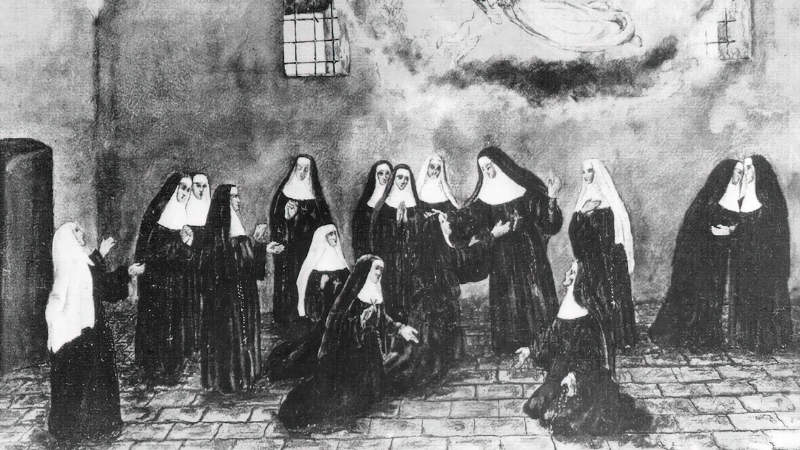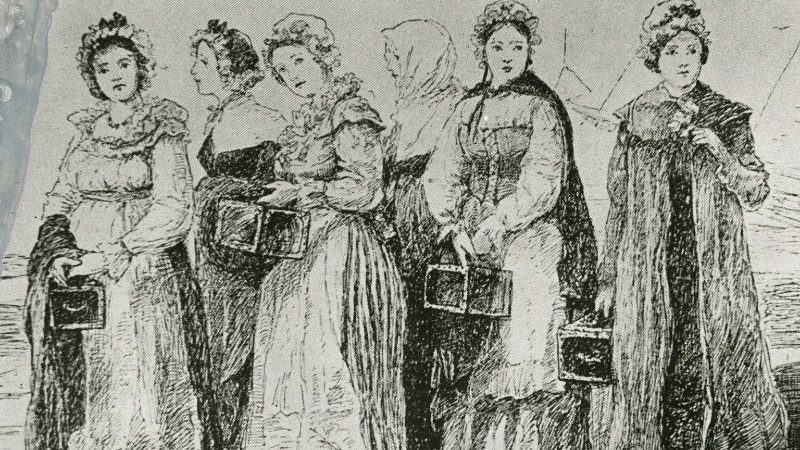Among New Orleans most haunting and controversial legends is that of the Casket Girls—young women sent from France in the early 18th century, whose arrival is shrouded in both romance and rumor.
Over time, their story has become a blend of verifiable history and macabre myth, woven so tightly together that separating fact from fiction often proves impossible.
Yet, it is precisely this combination that has immortalized the Casket Girls in the haunted folklore of New Orleans…
Who Were the Casket Girls?

The Casket Girls—known in French as “les filles à la cassette”—were young women sent by the French government and Catholic Church to the French colony of Louisiana in the early 1700s.
Their mission was both practical and deeply symbolic: they were to marry male settlers and help “civilize” the growing colony, providing structure and family life in what was then a rugged and often lawless land.
The term “casket” refers not to a coffin, as many people mistakenly believe, but to the small, coffin-shaped chests (or “casquettes”) these girls brought with them to carry their few belongings. However, the eerie resemblance of their travel trunks to miniature coffins would become a key detail in the legends that followed.
The Casket Girls first arrived in New Orleans around 1728, during a time when the colony was struggling with a gender imbalance.
The area had been settled by traders, soldiers, and fur trappers—mostly single men—and as a result, moral decay and lawlessness were common.
In an effort to establish a more stable society, the French King Louis XV and the Bishop of Quebec arranged to send young, pious women from convents, orphanages, and poor families in France to serve as wives to the colonists. These women were carefully selected for their virtue and religious upbringing, many coming from convents run by the Ursuline nuns.
Life in the Colony and the Ursuline Convent
Upon their arrival in New Orleans, the Casket Girls were taken in by the Old Ursuline Convent, which still stands today on Chartres Street and is one of the oldest buildings in the Mississippi Valley. There, the Ursuline nuns sheltered and supervised the girls until suitable marriages could be arranged.
While under the nuns’ care, the girls were taught housekeeping, sewing, and basic literacy skills meant to prepare them for their future lives as wives in the colony.
However, life in Louisiana was far more brutal than many of these girls had been led to believe.
The oppressive heat, rampant disease, and unstable social climate made their adjustment incredibly difficult. Many of the men they were intended to marry were rough, violent, and uninterested in the ideals of virtue and family.
Some girls did manage to marry and live relatively normal lives, while others fell into prostitution or suffered tragic fates, lost to the shadows of the colony’s darker side.
Origins of the Vampire Legend
The Casket Girls’ legend began to evolve as local folklore blended with fear, misunderstanding, and the deeply Catholic superstitions of the time. The Old Ursuline Convent became a central figure in the tales, particularly its third-floor attic, which was said to be sealed shut with nails blessed by the Pope himself.
Rumors swirled that the girls had not brought only hope and virtue to the colony, but something far more sinister.
Locals began to claim that the girls’ “caskets” were not chests at all, but actual coffins, and that they had arrived in New Orleans already pale and strangely silent. Some suggested that these young women were undead—vampires, brought to the New World under the guise of salvation.
The idea that their trunks contained their resting places added fuel to the fire, and when strange deaths began to be reported in the colony—people drained of blood, mysterious illnesses—superstitions flared.
The third floor of the convent, off-limits for centuries, only deepened the mystery. Even to this day, visitors are not allowed into that part of the building, which has led ghost hunters and paranormal investigators to speculate on what secrets it may hold.
Modern Investigations and the Paranormal Community
View this post on Instagram
In recent decades, the legend of the Casket Girls has become a favorite among paranormal researchers and ghost tour guides.
Numerous documentaries and books have referenced the tale, often blending historical detail with dramatized accounts of hauntings. Some claim that the attic of the Ursuline Convent radiates unexplainable energy, and paranormal activity in the building has been reported by multiple sources.
One of the most famous modern accounts involves a paranormal team that allegedly obtained permission to stay overnight at the convent.
According to legend, the team never made it out, vanishing without a trace and leaving behind only their blood-splattered equipment.
While this story lacks verifiable evidence and appears to be part of an urban legend, it continues to circulate widely and contributes to the enduring fear associated with the site.
Paranormal experts like those from the Travel Channel’s “Ghost Adventures” and various YouTube investigators have tried to access the third floor, but permission has never been granted. Even skeptics agree that the tight-lipped approach of the church and the Ursuline order only feeds the mystery.
Symbolism, Gender, and the Colonial Gaze
Beyond the supernatural, the story of the Casket Girls reveals important truths about gender roles, colonial history, and religious control. These women were commodified in the most literal sense—shipped across the ocean to become tools of social engineering.
While they were promoted as virtuous and obedient, their very presence became a target of suspicion and fear.
The colonial patriarchy saw women as necessary but dangerous: necessary to create order and reproduction, but dangerous if uncontrolled or unchaste. The rumors of vampirism, then, can be viewed through the lens of female “otherness” and repression.
The idea that these women arrived with secret powers, that they fed on the life of others, mirrors long-standing myths about dangerous femininity. Scholar Barbara Creed refers to such figures in her book The Monstrous-Feminine, exploring how female sexuality and independence are often mythologized as monstrous in folklore and horror.
The Casket Girls in Pop Culture
@notbuttaimb #stitch with @moviesaretherapy #greenscreen klaus is him #theoriginals #buttaimb #thevampirediaries ♬ original sound – NotButta
The mystique of the Casket Girls has made its way into popular culture, appearing in books, TV shows, and local art.
One notable example is the TV series “The Originals” (a spin-off of The Vampire Diaries), which references the legend in its storyline involving ancient vampires and New Orleans lore.
Writers and filmmakers have used the Casket Girls as symbols of mystery, horror, and resilience, though often in a romanticized or exaggerated form.
Additionally, local artists and storytellers keep their tales alive through French Quarter ghost tours, historic reenactments, and even themed merchandise. Yet, despite all the glamor and gothic horror, the true story remains one of survival, struggle, and cultural transformation.
Conclusion

Whether viewed as historical figures or supernatural beings, the Casket Girls continue to fascinate and terrify. Their story reflects not only the eerie charm of New Orleans but also the complexities of colonial history, gender politics, and the fine line between myth and memory.
The same spirit of haunting mystery that lingers in their story can be felt in the city’s iconic haunted hotels, where guests often claim to encounter the past in the form of unexplained apparitions and eerie sounds.
From their arrival as innocent brides-to-be to their transformation into spectral legends of the French Quarter, the Casket Girls embody the haunted soul of a city that never forgets its past.
Their legacy lives on not just in books and stories, but in the very walls of the Old Ursuline Convent, in the nightly whispers of ghost tours, and in the deep psychological resonance of being sent to an unknown land to marry strangers and build a life in the shadows of empire.

